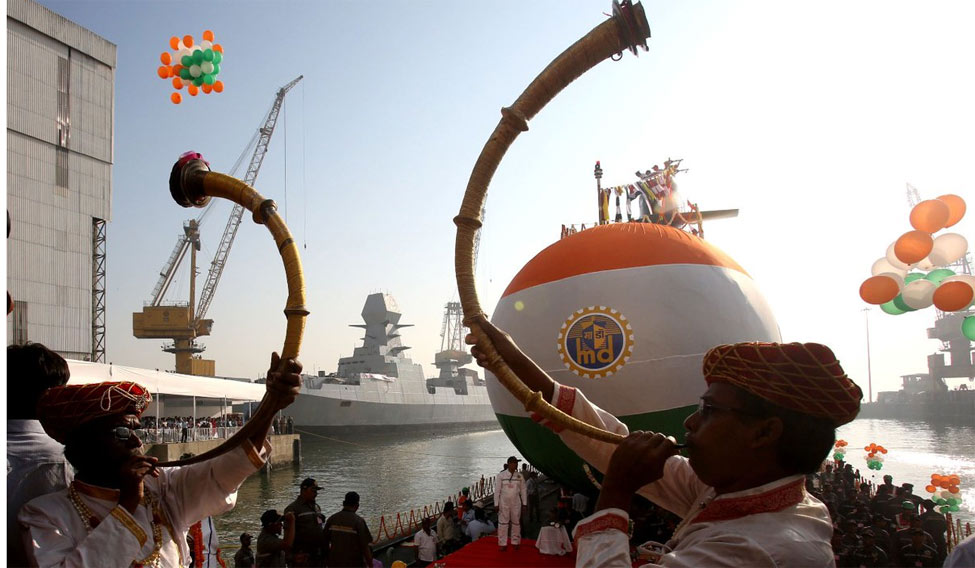Over a month after the first Scorpene-class submarine, Kalvari, joined the Indian Navy's underwater fleet, another submarine of the same class, Karanj, was launched at the Mazagon Dock Shipbuilders Limited at Mumbai on Wednesday.
However, the country's long-term plan to build 24 conventional submarines, announced in 1999, has been slow to pick up steam as no clarity exists on when 12 more vessels will be ordered.
The strength of the Indian Navy's submarine fleet has dwindled from a total of 21 submarines in the 1980s to 14 conventional submarines plus one homemade Arihant-class nuclear submarine and one Russian Akula-class submarine operating on lease.
To make the situation more worse, at any given point of time, the Indian Navy is operating with half of its submarine fleet strength as most of them are in the last leg of their active operational lives and are undergoing mid-life upgrades. And the matter raises serious concerns when we compare it with our neighbour China, which has a strength of 65 subs.
Ideally, the navy needs at least 24 submarines to meet the goals of the 30-year submarine building plan, which was approved by the Cabinet Committee on Security in 1999, months after the Kargil conflict.
The 1999 acquisition program was divided into three sections: first, six Scorpene submarines to be procured under Project 75; second, six more submarines to be built under Project 75-India and third, the remaining 12 vessels to be build ingenuously.
Last year, on 14 December, INS Kalvari, the first Scorpene-class submarine was commissioned into the Indian Navy, by Prime Minister Narendra Modi. Khanderi, the second Scorpene-class submarine, was launched at MDL in January 2017 and is currently undergoing the rigorous phase of sea trials and is also scheduled to be delivered shortly to the Navy for service.
The contract to build six submarines in India was signed in 2006 between the French firm Naval Group, formerly known as DCNS, and MDL under the Indian Navy’s $3 billion Project-75. While the project was originally scheduled to deliver its first vessel by 2012, it has witnessed repeated delays.
The state-of-the-art technology utilised for construction of the Scorpene-class submarines has ensured superior stealth features such as advanced acoustic silencing techniques, low radiated noise levels, hydrodynamically optimised shape and the ability to launch a crippling attack on the enemy using precision-guided weapons.
"The attack can be launched with both torpedoes and tube-launched anti-ship missiles, while underwater or on surface. The stealth of this potent platform is enhanced by the special attention given to various signatures. These stealth features give it an invulnerability, unmatched by most submarines," said an official.
The 66-metre-long Scorpene is made up of a special kind of high-tensile steel, which ensures that the warship can withstand high-yield stress, allowing it to dive deeper. The submarine can operate at a depth of 300 metres underwater and travel 1,020km underwater. It can carry 18 torpedoes and tube-launched anti-ship missiles that can be fired underwater or from the surface.
Scorpene submarines can undertake multifarious types of missions i.e., anti-surface warfare, anti-submarine warfare, intelligence gathering, mine laying, area surveillance etc. The submarine is designed to operate in all theatres, with means provided to ensure interoperability with other components of a naval task force. It is a potent platform, marking a generational shift in submarine operations.
The Scorpene-class submarine project will not only enhance the navy's underwater capabilities, but will be a big leap towards Indian self-reliance in the defence sector under the 'Make in India' initiative. The Navy got it last Indian-made submarine in the early 1990s when two HDW-class submarines, INS Shalki and INS Shankul, joined the Indian Navy.
India got the first of eight Foxtrot-class submarines, also known as INS Kalvari, on December 8, 1967, when it was commissioned at the then Soviet Union’s naval base Riga in Latvia.





